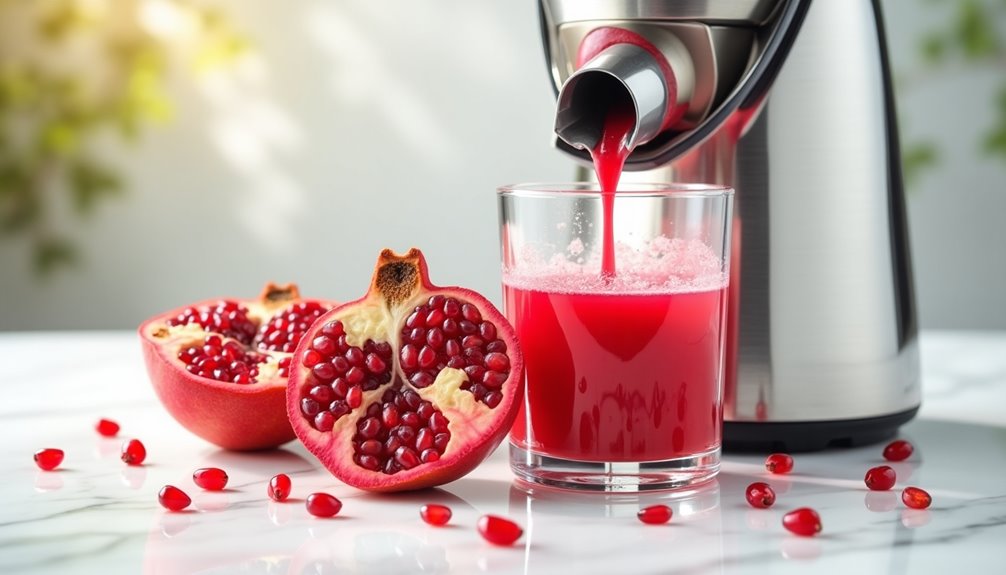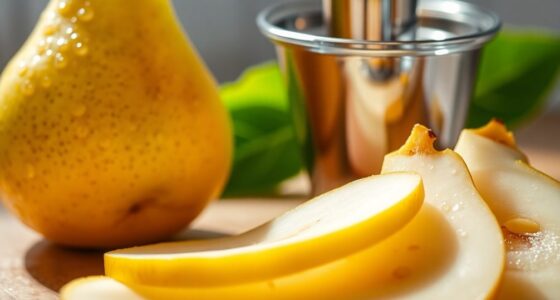To juice a pomegranate, start by cutting it in half and tapping out the seeds into a bowl. Rinse the seeds under cold water to remove any pulp. Then, feed the rinsed seeds slowly into your juicer, like a Kuvings Whole Slow Juicer. You'll get about 8 to 9 ounces of vibrant pink juice. If it's too tart, try mixing it with other fruit juices for a balanced flavor. Keep going to discover more tips!
Key Takeaways
- Cut the pomegranate in half and gently tap the seeds into a bowl for easy extraction.
- Rinse the seeds under cold water to separate pulp and ensure a clean juicing process.
- Use a slow juicer, like a Kuvings, to maximize juice yield and flavor.
- Expect to yield about 8 to 9 ounces of juice from two medium-sized pomegranates.
- If the juice is too tart, mix it with other fruit juices for a balanced flavor.

Juicing a pomegranate can seem daunting, but once you get the hang of it, you'll find it's a rewarding process. The first step is to prepare your pomegranate fruit properly. Start by cutting the fruit in half crosswise. This method reveals the beautiful array of pomegranate seeds inside. To extract the seeds, you'll want to gently tap them out into a bowl using a wooden spatula or spoon. It takes a little finesse, but soon you'll be a pro at it.
If you're struggling to get those seeds out, try making a shallow cut around the top of the pomegranate, then slice the fruit into wedges along the white pith lines. This technique exposes the seeds further and makes it easier to remove them from the rind.
Once you've got a bowl full of fresh pomegranate seeds, it's time to rinse them under cold water. This helps to separate any pulp that might be lingering and ensures that your juice is clean and pure.
Now that you have your pomegranate seeds prepped, it's time to move on to juicing. If you have a juicer, like a Kuvings Whole Slow Juicer, you're in luck! This type of juicer is perfect for extracting juice from pomegranate seeds. Just feed the rinsed seeds into the juicer, allowing it to process each portion slowly.
This slow extraction method is key, as it maximizes how much juice you'll get from your pomegranates. Expect to yield about 8 to 9 ounces of juice from two medium-sized pomegranates, which is quite a bit of liquid considering how labor-intensive it can seem at first.
Once the juicing is done, you'll notice the final product has a gorgeous pinkish burgundy color. The taste of pomegranate juice is unique, with a sour yet palatable flavor that many people enjoy. If you find it too tart for your liking, consider balancing it out by mixing it with other fruit juices. This not only enhances the flavor but can also add more nutritional benefits.
Frequently Asked Questions
Can I Put Pomegranate in the Juicer?
Yes, you can put pomegranate seeds in the juicer! Just remember to remove the seeds from the fruit first.
Cut the pomegranate and gently pull out the arils, avoiding any excess white pulp. Using a slow juicer helps maximize juice yield while keeping all the nutrients intact.
On average, two medium-sized pomegranates will give you about 8 to 9 ounces of delicious, healthy juice packed with vitamins and antioxidants.
Enjoy!
Do You Have to Peel a Pomegranate Before Juicing?
Juicing a pomegranate's like unraveling a treasure chest; you don't need to peel it first.
Instead, just remove the juicy seeds, or arils, from the rind. Cut the pomegranate and gently pry out the seeds from the pith.
After that, rinse them to get rid of any leftover pulp. Your juicer will efficiently extract the juice directly from the seeds, saving you time and effort.
Is Pom Really 100% Pomegranate Juice?
Yes, POM Wonderful claims their juice is 100% pomegranate juice, made from California-grown pomegranates without any added sugars or preservatives.
You can trust that each bottle contains the juice of about two whole pomegranates, and they emphasize the health benefits, including antioxidants and vitamins.
POM tests their juice for purity and adheres to strict quality standards, ensuring you're getting a high-quality product every time you pour a glass.
How to Juice a Pomegranate Hack?
If you're looking for a hack to juice a pomegranate, try using a microwave!
Just cut the pomegranate in half, then microwave each half for about 30 seconds. This softens the fruit and helps release the juice.
Next, hold the half over a bowl and squeeze it firmly. You’ll get a good amount of juice without the mess of extracting seeds. To enhance the flavor of your dishes or beverages, consider adding a touch of sweetness from fresh peach juice. For those wondering how to juice a peach, this method not only minimizes mess but also maximizes the amount of juice you can extract. After squeezing, you can strain the juice to remove any pulp, creating a smooth and delicious addition to smoothies, cocktails, or salad dressings.
It's a quick, easy way to enjoy fresh pomegranate juice!
Conclusion
Juicing a pomegranate can feel like a messy battle, but the sweet reward is worth every drop. As you watch the vibrant red juice flow, remember that the effort contrasts sharply with the refreshing burst of flavor you're about to enjoy. It's a small reminder that sometimes, the best things come from a little hard work. So, embrace the process, relish the results, and savor each sip of your homemade pomegranate juice—it's nature's treat in a glass!
Cindy thoroughly researches juicing trends, techniques, and recipes to provide readers with practical advice and inspiration. Her writing style is accessible, engaging, and designed to make complex concepts easy to understand. Cindy’s dedication to promoting the advantages of juicing shines through her work, empowering readers to make positive changes in their lives through the simple act of juicing.










